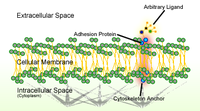
Photo from wikipedia
By analyzing the distributions of focal adhesion (FA) lifetimes from different cell types, we found that a gamma distribution best matched the experimental distributions. In all but one case, it… Click to show full abstract
By analyzing the distributions of focal adhesion (FA) lifetimes from different cell types, we found that a gamma distribution best matched the experimental distributions. In all but one case, it was a unimodal, non-symmetric gamma distribution. We used a mathematical model of cell motion to help understand the mechanics and data behind the FA lifetime distributions. The model uses a detach-rate function to determine how long a FA will persist before it detaches. The detach-rate function that produced distributions with a best fit gamma curve that closely matched that of the data was both force and time dependent. Using the data gathered from the matching simulations, we calculated both the cell speed and mean FA lifetime and compared them. Where available, we also compared this relationship to that of the experimental data and found that the simulation reasonably matches it in most cases. In both the simulations and experimental data, the cell speed and mean FA lifetime are related, with longer mean lifetimes being indicative of slower speeds. We suspect that one of the main predictors of cell speed for migrating cells is the distribution of the FA lifetimes.
Journal Title: Biophysical journal
Year Published: 2022
Link to full text (if available)
Share on Social Media: Sign Up to like & get
recommendations!